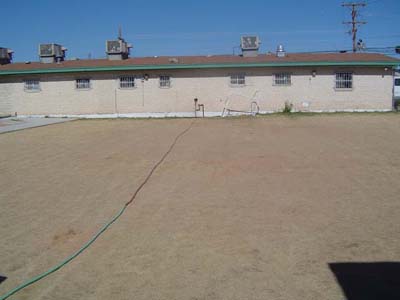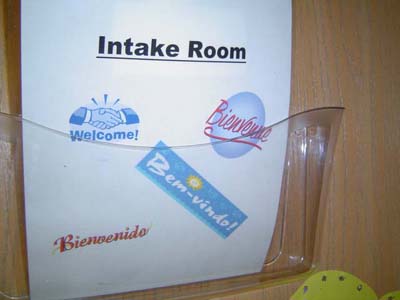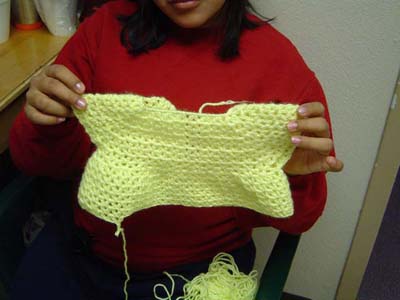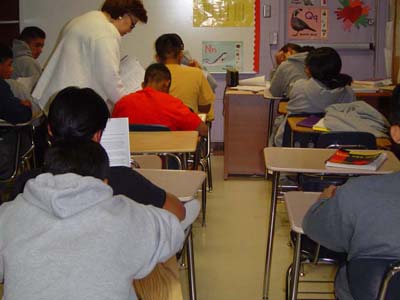
Three boys stumble out of the back of a border patrol van. Their sweatshirts, jeans, and boots are filthy, and their lips are flaky. One boy has red cheeks, chapped by the cold desert wind. The boys each clutch a small bag. They are silent and watchful as their driver – a man in a green uniform with a gun on his belt – hands them over to a woman in the parking lot of a low-slung brick building near El Paso. “Mucho gusto, jóvenes,” the woman says to them. The boy with the red cheeks understands the most Spanish. At home, in their small village in southwestern Guatemala, the boys speak Mam, a Mayan dialect.
The woman unlocks the building’s front door with a plastic card and ushers them into a small room painted lavender. The driver hands her three folders containing the boys’ fingerprints and mug shots.
The boys sit at a square table in the center of the room and take in the scene. A colorful painting of an indigenous woman holding calla lilies dominates the back wall. The adults who pop in and out wear radios on their belts instead of guns and street clothes instead of uniforms. “This is a house for children,” the woman from the parking lot tells them. “All we have here are children.”
What she calls a house is actually a shelter – one of 30 across the country – for kids who are in the country illegally and unaccompanied by a parent or guardian. It’s federally funded but operated by a nonprofit organization called Southwest Key.
A youth-care worker named David Escarsega takes a seat at the table and speaks with the boys in a soft voice. He wants to know their names, ages, whether they have allergies, and whether they have family in the United States. He also asks about their families in Guatemala.
The boys offer up the details on their fake birth certificates, presenting themselves as Carlos, Ignacio, and José Fernando, rather than Diego, Antonio, and Martín. They claim to be 16 and 15. They have no facial hair and are not much taller than a 9-year-old who was recently brought in, but Escarsega writes what they tell him on his forms. The truth will emerge later, when their caseworkers obtain their real birth certificates.
A woman appears with food on Styrofoam plates: each boy gets two ham-and-cheese sandwiches, a bag of potato chips, and an orange. As they eat, Escarsega puts on surgical-style rubber gloves and picks through Diego’s bag: a baseball cap, a knit hat, a sweater, a T-shirt, and ankle socks with “USA” stitched on them. The room takes on a rank odor.
The boys left Guatemala two weeks earlier. After seven days on a bus, they were deposited in the Mexican desert by their coyote, or smuggler. Diego says they walked for two days, following the lights of a city, and that they were sitting on the ground, discussing what to do next, when men in green uniforms surrounded them. Over the next several days, he continues, they were handcuffed, hit, asked questions, told nothing.
Antonio sniffles every now and then – he caught a cold in the desert – but is otherwise quiet. Like Martín, he does not speak Spanish well. The boys have had little schooling. They have planted crops for most of their lives.
Diego takes charge. He asks when they can leave.
Escarsega says he doesn’t know. He counts out five changes of clothes – sweatpants, T-shirts, underwear, socks – and hands them to Diego.
The boy looks alarmed. “Why?” he asks. He doesn’t need these clothes. “Voy a ir mañana.” I’m leaving tomorrow.
But before the boys can go anywhere they must face removal proceedings before the Executive Office for Immigration Review – and that process usually takes at least a month. After a judge orders removal or deportation, a detained minor still has to wait – usually another month or so – for the appropriate consulate to issue travel papers.
“What day can I leave?” Diego asks.
As Escarsega explains that he doesn’t have the authority to release the boys, the gravity of the situation dawns on Diego. “Voy a ir mañana,” he repeats, sounding simultaneously fragile and resolute. Antonio and Martín watch Diego with growing concern. His voice breaks as he explains that he borrowed around $4,000 to pay the coyote. He needs to pay off the loan, and if he can’t stay in the United States and work, he needs to go home and plant beans instead.
Escarsega isn’t unsympathetic, but there’s nothing he can do. The boys don’t understand why they can’t just leave. Diego starts to cry, which sets off Antonio and Martín. Soon all three are wiping their eyes with their dirty sleeves.
“The money that I borrowed to go to the United States,” Diego says. “The interest is active.”
Escarsega is silent.
“I have to go right now,” Diego wails. “I’m going to die. Where am I going to find that money?”
Diego finally collects himself, looks at Escarsega, and pleads, “Can you help me, sir?”
A woman enters the room and asks the boys’ shoe sizes. “I don’t want shoes!” Diego says. “I want to go home.”
This provokes a new round of crying. The boys whisper to each other in Mam. Diego stands up, faces the wall, and rubs his eyes. When he turns around, he glances up at the window. It has burglar bars.
I’m leaving tomorrow, he insists.
When Escarsega finishes filling out his forms and taking inventory of the boys’ belongings, each boy is led to a bathroom for a shower and a delousing treatment. They will stay in quarantine with other new arrivals for the next few days – until they get vaccinated and a doctor determines they don’t have any contagious diseases.
“Keep a close eye on them,” Escarsega warns the staff on the intake wing. “I think they will run. They’re very depressed right now.”
The El Paso shelter can house 94 unaccompanied minors. Its three ranch-style buildings (two residential, one educational) surround a small soccer field and a landscaped brick patio with a waterfall pond.
The U.S. has a “catch-and-release” policy with Mexico, so the kids detained here are almost all from other Central American countries, mainly Guatemala, Honduras, and El Salvador. The average stay is 48 days.
The number of unaccompanied minors in federal custody has grown significantly each year since 9/11, likely a result of increased security at the borders. The government detained 7,897 last year – a 22 percent jump from the year before. Responsibility for their custody and care falls to the Office of Refugee Resettlement, which is part of the Department of Health and Human Services. ORR places some kids in small group homes or foster homes, and others in large shelters like this one.
By the time they get to the U.S., most unaccompanied minors have endured hardship both in their home countries and on their journeys. Often they’ve traveled for weeks or months in difficult and dangerous conditions: They might strap themselves to the top of a boxcar with rope they’ve made from agave fiber, stow away in a luggage compartment of a bus, or walk for days with little food or water. Sometimes they are robbed, beaten, or raped along the way.
Many, like the Guatemalan boys, are fleeing poverty. Others are running from even more dire circumstances – they’ve been forced into prostitution, made to fight in a guerrilla war, targeted by violent street gangs, or tortured by police. Some simply hope to reunite with relatives.
“The fact that they’ve traveled to the United States on their own demands respect, because it takes a lot of courage,” says Connie Zamora-Perez, the Southwest Key program director who runs the shelter near El Paso. Like the Guatemalan boys, most kids arrive rattled and worried. Their plans have been upended, and they soon realize their journeys may have been for naught. The U.S. wants to send them back to the trouble they’ve risked so much to escape.
Most want to leave the shelter soon as possible. “The bottom line is that this wasn’t their destination,” says Zamora-Perez. “We’re another obstacle.”
Fourteen newcomers, including Diego and his friends, are admitted to the intake wing the first weekend of February, pushing the shelter to near capacity. Red, purple, and pink streamers stretch across the hall. Paper hearts decorate the walls, bearing such sentiments as “Amor” and “Feliz Día De San Valentín” written in glitter.

At all hours, a youth-care worker is posted in the middle of the hall to answer questions, grant permission to use the bathroom, and administer ointment for foot fungus. Nearly all the new arrivals need it.
After they shower and change into their sweat clothes, the kids settle into their rooms. They are assigned bunks and drawers. They learn how to make their beds and fold their clothes. They learn the house rules. They meet with a caseworker, who attempts to contact their families – sometimes through radio broadcasts in remote villages – and a clinician, who assesses their need for psychological counseling.
They get a haircut. They see a doctor. They take an academic exam, but leave most of the answers blank. How many years has Mayan culture existed? Antonio zeroes in on the words “cuántos años” and writes 15 – the age he’s claiming to be. Martín doesn’t even know how to write – he signs his name with an X. When the boys are left alone, they sit on the floor of their bedrooms and play with Legos or marbles. Or they sit on their beds and cry.
The woman from the parking lot, Marilyn Payan, comes to talk to them. She brings along a shy 15-year-old girl from the general population to interpret. The girl has ornate crowns on her four front teeth, and when she smiles, she shows a mouthful of silver stars. She leans back against the door and quietly repeats in Mam what Payan says in Spanish. You have to go to school here. You can’t work. Diego says they need to leave, that they have jobs lined up. He has construction work in Washington, D.C. Antonio and Martín have restaurant jobs in Sarasota.

Kids on the intake wing are supposed to stay in their rooms, but boredom and curiosity compel them to open their doors, stick out their heads, and stare at each other. Victor, an 11-year-old orphan from Honduras, has a knack for cracking everyone up, including himself. He laughs with his mouth wide open. His constant joking endears people to him but has the staff slightly worried. He quickly gets pegged as a “handful.”
A quiet 15-year-old named Eguin occupies the room across the hall from Victor. His coyote abandoned him and a few other migrants in a ranch house after they crossed the border. They waited eight days for another coyote, turning themselves in when they could no longer bear the hunger. A 16-year-old named Orlin spends much of his first day in the bathroom, vomiting. Like the Guatemalan boys, he says he was hit by a border patrol agent.
The girls stay down the hall. Sandra, a 17-year-old from El Salvador with a long ponytail and pink nails, is polite and inquisitive. Upon learning that she will be taught English here, she smiles and raises her eyebrows in gleeful astonishment. Her roommate, 17-year-old Rosa, was separated from her 19-year-old husband when the border patrol discovered she was a minor. Rosa doesn’t know where he is or when she will see him again. Maria, 17, spends her days crocheting baby clothes. She’s been on the intake wing unusually long – about a month. The isolation is for her safety, according to staff. She is six months pregnant.

Newcomers usually join the general population after four days. The quarantine is a relatively new procedure, implemented last year after chicken pox outbreaks halted operations for three months. In that time, no one could go to court and no one could be released. For kids like Diego with huge debts growing daily, the wait for release can seem interminable.
“Do you understand why you are here?” a woman asks the Guatemalan boys a few days after they arrive. The girl with stars for teeth interprets. The boys bashfully shake their heads. No, they don’t really understand why they are here.
“One has to have the proper documents in order to enter the country legally,” she says. “So the government wants you to return to your own country.” Then she says, “I am not part of the government. I don’t represent the government. I don’t have anything to do with the government.”
The woman, Betsy Rodriguez, is a volunteer for Las Americas Immigrant Advocacy Center. “We want to help you,” she says. “We are in charge of your legal cases.”
To stay in the U.S. legally, unaccompanied minors must have a parent here legally, be granted political asylum, or qualify for one of the special visas the government gives to abused, neglected, abandoned, or trafficked children.
But the government does nothing to help unaccompanied minors exercise their rights. Immigration court is part of the executive rather than the judicial branch, and the rules are different. The government doesn’t appoint attorneys for unaccompanied minors. Nor does it provide them with guardians ad litem, as is standard in most juvenile courts. In immigration proceedings, the best interest of the child is not usually a factor. If minors succeed with their claims for immigration relief – if they even know to make a claim – it’s only because pro bono attorneys or organizations like Las Americas have stepped in.
This may soon change. A bill requiring that all unaccompanied minors have access to legal counsel and guardians ad litem recently passed the Senate.
In the meantime, Las Americas does what it can for the detained kids in El Paso. Volunteers like Rodriguez come to the shelter several times a week to provide “know your rights” seminars and to identify those who may have a shot at lawful residency. Judy Bourg, Las Americas’ legal representative, handles the kids’ cases. She’s a nun, not a lawyer, but she has received training in immigration proceedings and has been approved by the Executive Office for Immigration Review to represent undocumented immigrants.
As the Department of Homeland Security takes steps to deport juveniles at the shelter, their caseworkers search for suitable sponsors – usually relatives – to release them to while the removal proceedings are pending. Those placements must first be approved by ORR. Typically half the kids wind up with sponsors.
Rodriguez asks the Guatemalan boys if they have family in the U.S. They say they do. The process of connecting detained minors with their state side relatives is “like a race with the court,” she tells the boys. If the necessary documents – including proof of employment, birth certificates establishing the sponsor’s relationship with the child, and the results of a background check–haven’t been submitted to ORR and approved by the fourth court date, the judge will probably order deportation.
She asks the boys how long they think getting released to a relative might take. “Nine days?” Diego guesses. Rodriguez gently breaks the news: it can take many months.
The removal process can also take months. Kids without a claim for immigration relief can choose between voluntary departure and deportation. The former may be the better option if a family can afford it; if children are deported at government expense, they can’t return legally for ten years. In either case, the children have to wait for visits from their consular representatives, who will provide them with the proper travel documents.
When minors fight deportation, the odds are against them. “The asylum law is very narrow, especially for children,” says Bourg.
Asylum seekers, whether adults or children, must demonstrate that if they return home they’ll be persecuted on account of their ethnicity, race, political opinion, religion, or membership in a particular social group. In recent years, advocates for the growing population of unaccompanied minors have criticized asylum law for failing to recognize child-specific forms of persecution. Immigration lawyers across the country have begun arguing, with some success, that street children from certain Central American countries constitute a persecuted social group, since they’re targeted by youth gangs. Similar arguments have been made on behalf of kids who refuse to follow gang orders or attempt to sever gang ties.
In early 2004, 16-year-old Edgar Chocoy filed an asylum claim in Denver, arguing that the notorious Mara Salvatrucha gang would kill him as punishment for defecting if he returned to Guatemala. According to the Boulder Weekly, the judge wasn’t persuaded by the boy’s testimony or by reports of the 30 to 40 children murdered by gangs every month in Guatemala. Seventeen days after being deported, Chocoy was shot dead by a member of his former gang.
Like the Denver judge, judges in El Paso, says Bourg, “are not convinced yet” that the threat posed by street gangs amounts to persecution. In the past two years, they’ve deported all five of Bourg’s clients who made asylum claims based on their fear of gang violence.
Bourg was recently preparing a case for a boy at the shelter who’d refused to carry out a gang’s order to kill someone. After getting into a fistfight, however, he was transferred to a shelter in Washington state. “We believe it was like the hand of God,” says Bourg, “because now he’s in the Ninth Circuit.” The judges there, she says, are more open to gang-related persecution claims.
Asylum cases can take years to resolve, and detained minors often abandon their claims. One of Bourg’s clients who was about to turn 18 withdrew her appeal after 11 months when she learned that on her birthday, she’d be transferred to an adult jail.
A 16-year-old Honduran boy who’s been at the shelter for four months and who has a different possible avenue of relief also recently asked a judge for removal – against the advice of Las Americas. He has a scar that runs vertically along his elbow from an injury he got falling off a freight train during one of his nine attempts in two years to make it to the United States. “It’s easier for me to return and try to come back,” he says. He hopes he won’t get caught next time.
One of the first English words the kids learn is teacher. They call every adult teacher, whether they’re talking to a caseworker, a clinician, a youth-care worker, the program director, or their actual teacher. “Buenos dias, Teacher Arturo,” they say. And “Teacher Carmen, can I use the bathroom?”
Within five days of arriving, Diego, Antonio, and Martín join the general population in Building A. One day while Diego and Antonio are standing in line for Kool-Aid, a former gang member from Honduras who’s been written up several times for bad behavior cuts in front of them.
Rather than start a fight, they tell Teacher Ruben about the incident. Later that day, at a “community” meeting, Teacher Ruben makes a speech urging the kids to remember where they came from. Everyone here has been through a lot of stress and frustration, he says. Be an example. Help each other out.
Most of the kids have worked their whole lives and had little if any schooling. Here they learn English, math, and science. They also take vocational classes: computers, drafting, carpentry.
They meet with their caseworkers at least twice a week. They eat more than they ever have – three meals and two snacks a day. Their scrawny bodies, wasted from chronic deprivation or from the difficult weeks or months on the road, quickly start filling out.
They make friends. They test out bits of English. They do chores – mopping, sweeping, emptying the garbage – and in their downtime play Connect Four, chess, and cards. They weave colorful yarn bracelets, often making complicated patterns or spelling out their names.
They get to do things here they have never done before: bowl, attend college basketball games, see movies, go to museums. On such outings they point admiringly to the SUVs and sleek sedans that clog El Paso’s streets or whiz past them on I-10. “That one is mine,” the girls call out from the back of the Southwest Key van. “Teacher,” say the boys, “What kind is that one? How much does it cost?”
Detained kids had fewer privileges before March 2003, when the Homeland Security Act transferred custody of unaccompanied minors to ORR from the Immigration and Naturalization Service. The new system treats kids with “more of a heart,” according to Margie Quesada, the lead caseworker at the shelter. But critics complain that ORR has made life too pleasant for unaccompanied minors. Don Barnett, a Center for Immigration Studies fellow, asserted in an article that the shelters are now “more like summer camps than detention centers.” Barnett partly blames ORR for the growth of the unaccompanied minor population, claiming the changes it implemented when it took over from INS make illegal immigration “more attractive.”
But Southwest Key’s Zamora-Perez looks at it differently. She says that if her children found themselves separated from her in a foreign country, “I would be happy to know that there was a shelter like this available that could take care of them until I could get to them.”
Still, the head counts and post-outing pat downs the detained minors endure serve as frequent reminders of their predicament. And the thrill of new experiences does not eclipse their misery. On any given day, someone is sobbing on the phone or brooding on the couch. So much can go wrong, and does. A judge orders deportation. ORR rejects a sponsor. A prospective sponsor refuses to help. (Helping can be risky when sponsors are also undocumented: they have to get fingerprinted, come to the shelter to pick up the child, and pass through a border patrol checkpoint on the way out of El Paso.)
Sometimes, there’s bad news from home – a death in the family; a friend killed by a gang; a coyote demanding payment. Diego has a tearful phone conversation with his mother a few days after he arrives: she tells him his father has been on a drinking binge since he left.
Staff members monitor the behavior and emotional state of each child, but they are prohibited from touching any child. Instead of hugging kids who are sad, staff members talk to them and allow them to have extra phone calls, time alone in their rooms, or breaks from their daily routines.
Occasionally a kid tries to escape. Last year one succeeded and two were caught in the attempt. Those with deportation or removal orders are assumed to be “run risks” and denied regular outings. Not long ago, a boy broke off a piece of his bed and used it to dig out part of the wall near his window. There are kids here now who seem to want to test the limits. One was recently caught shaking the fence that surrounds the property.
One day at lunch a 16-year-old named Ana shoves aside her tacos, puts her head on the table, and begins to cry. Her friend Jessica, also 16, whispers into her ear, then lifts Ana’s fingers one at a time, counting “Uno, dos, tres.” Eventually Ana lifts her head and smiles.
Ana hopes to be released to a woman in Chicago, the daughter of a couple she worked for in Guatemala City. But today she got some bad news: ORR has ordered a suitability study of the sponsor’s home. If a placement seems questionable – and in this case it does, since Ana and the woman have never met – suitability studies help ORR feel confident it is releasing the child to a safe home. But from Ana’s perspective, a suitability study just means that she has to wait longer before she’s released.
Ana is one of the few here who may be able to stay in the country legally. Her childhood was marked by violence. Her father terrorized her mother, beating her frequently and chasing her into the streets with a machete. At ten, Ana moved in with an older brother who tried to molest her. At 13, she found work helping a woman tend to her wheelchair-bound husband. After he died, the woman encouraged Ana to go to school, but Ana rarely ventured outside, fearing the violent gangs that roamed the streets.
Between 2001 and 2004, more than a thousand women and girls were murdered in Guatemala, according to Amnesty International. Most, like Ana, lived in poor urban areas and were domestic employees or shop or factory workers. One day last summer, during a rare outing, Ana was cornered by gang members who threatened to rape her. She avoided the rape by claiming she had AIDS, but still wound up badly beaten.
She says her father refused to take her to a doctor and that the gang members, upon learning she’d lied to them, marked her for death. She tried to beat them to it, slicing one of her wrists with a razor. An older relative intervened and then urged her to leave the country. After 20 days on the road, the U.S. border patrol caught her in a coyote’s van, heading to Phoenix. She claimed to be Mexican, as her coyote had instructed, thinking she’d just be dropped over the border. But after Mexican authorities quizzed her on the colors of the Mexican flag, she admitted she was Guatemalan and was turned back over to U.S. agents.
Las Americas quickly identified her as a possible candidate for a Special Immigrant Juvenile Visa (SIJV), which allows kids who’ve been neglected, abandoned, or abused to become lawful permanent residents. Bourg has obtained letters from Ana’s mother and sisters-in-law corroborating her story.
To acquire SIJ status, however, unaccompanied minors must persuade a family or juvenile court judge that they are eligible for long-term foster care and that it’s not in their best interest to return to their country.
But to even get access to a state court where these things would be determined, detained minors need the consent of U.S. Immigration and Customs Enforcement. Bourg says this is a major hurdle: ICE is part of the Department of Homeland Security – which is actively trying to deport the minors.
Advocates for unaccompanied minors see this as an obvious conflict of interest and maintain that consent gets withheld for no good reason. They point to the ruling of a federal judge in Seattle last December stating that ICE had abused its discretion by withholding consent for a 17-year-old boy and that the juvenile program director had acted “arbitrarily and capriciously.”
Like the asylum process, the SIJ process is slow. After four months at the shelter, Ana is still waiting for consent. Quesada says she knows of only three kids at the shelter who’ve received SIJ status in ten years. “Almost all the kids I’ve seen start the process end up giving up,” she says. Eight gave up in the last year alone. Most get discouraged when they see other kids failing to get consent, she says.
Ana isn’t ready to give up. The thought of returning to Guatemala terrifies her. “I imagine I would only be able to live 15 days,” she says.
Within a week, yarn bracelets cover Diego’s wrists. Antonio’s Spanish has improved. Martín has learned to write his name. They no longer need to stick together. New friendships have started to form.

Diego joins a class that has 11 other students. Three of them cannot read or write, and many puzzle over math problems by counting on their fingers or using an abacus. When the teacher introduces Diego, the students call out in unison, “Bienvenido.”
The teacher points Diego to an empty desk in the front row. He says the class is taking a break and hands Diego lyrics to a song by the defunct Mexican pop band Los Bukis. He hits play on a boom box, the music swells, and the class begins to sing.
Diego cannot read the lyrics, but he stares at them anyway.
Es verdad, me he enamorado de ti
Cuando menos esperaba
Instead of working off his debt on a construction site, he is sitting in a moss-colored classroom in brand-new clothing, listening to a love song with a wall of U.S. presidents staring down at him. Picking up the chorus, he starts to sing along, tentatively at first and then with some feeling. After the music dies down, the teacher turns off the boom box and asks, “Did you like it, Diego? Do you want to sing it again?”
Later, Diego continues to tell staff that he’s sad and worried and that he needs to go home. But for now he is able to enjoy this. “Yes,” he says. “Yes.”
©2006Tori Marlan.
Tori Marlan, a staff writer for The Chicago Reader, is examining the plight of undocumented immigrant minors during her fellowship.

